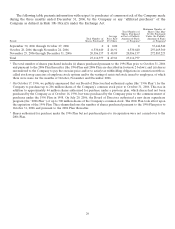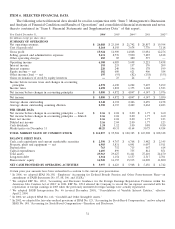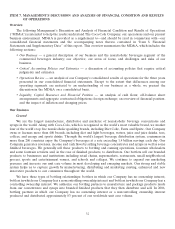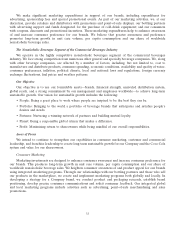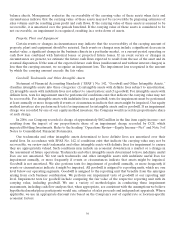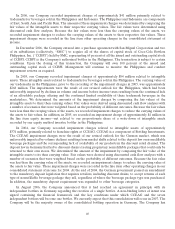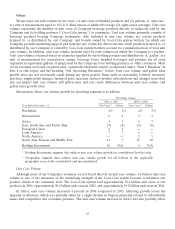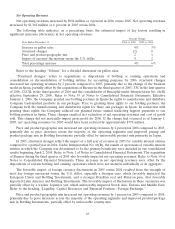Coca Cola 2006 Annual Report Download - page 41
Download and view the complete annual report
Please find page 41 of the 2006 Coca Cola annual report below. You can navigate through the pages in the report by either clicking on the pages listed below, or by using the keyword search tool below to find specific information within the annual report.balance sheets. Management evaluates the recoverability of the carrying value of these assets when facts and
circumstances indicate that the carrying value of these assets may not be recoverable by preparing estimates of
sales volume and the resulting gross profit and cash flows. If the carrying value of these assets is assessed to be
recoverable, it is amortized over the periods benefited. If the carrying value of these assets is considered to be
not recoverable, an impairment is recognized, resulting in a write-down of assets.
Property, Plant and Equipment
Certain events or changes in circumstances may indicate that the recoverability of the carrying amount of
property, plant and equipment should be assessed. Such events or changes may include a significant decrease in
market value, a significant change in the business climate in a particular market, or a current-period operating or
cash flow loss combined with historical losses or projected future losses. If an event occurs or changes in
circumstances are present, we estimate the future cash flows expected to result from the use of the asset and its
eventual disposition. If the sum of the expected future cash flows (undiscounted and without interest charges) is
less than the carrying amount, we recognize an impairment loss. The impairment loss recognized is the amount
by which the carrying amount exceeds the fair value.
Goodwill, Trademarks and Other Intangible Assets
Statement of Financial Accounting Standards (‘‘SFAS’’) No. 142, ‘‘Goodwill and Other Intangible Assets,’’
classifies intangible assets into three categories: (1) intangible assets with definite lives subject to amortization;
(2) intangible assets with indefinite lives not subject to amortization; and (3) goodwill. For intangible assets with
definite lives, tests for impairment must be performed if conditions exist that indicate the carrying value may not
be recoverable. For intangible assets with indefinite lives and goodwill, tests for impairment must be performed
at least annually or more frequently if events or circumstances indicate that assets might be impaired. Our equity
method investees also perform such tests for impairment for intangible assets and/or goodwill. If an impairment
charge was recorded by one of our equity method investees, the Company would record its proportionate share
of such charge.
In 2006, our Company recorded a charge of approximately $602 million in the line item equity income—net
resulting from the impact of our proportionate share of an impairment charge recorded by CCE, which
impacted Bottling Investments. Refer to the heading ‘‘Operations Review—Equity Income—Net’’ and Note 3 of
Notes to Consolidated Financial Statements.
Our trademarks and other intangible assets determined to have definite lives are amortized over their
useful lives. In accordance with SFAS No. 142, if conditions exist that indicate the carrying value may not be
recoverable, we review such trademarks and other intangible assets with definite lives for impairment to ensure
they are appropriately valued. Such conditions may include an economic downturn in a market or a change in
the assessment of future operations. Trademarks and other intangible assets determined to have indefinite useful
lives are not amortized. We test such trademarks and other intangible assets with indefinite useful lives for
impairment annually, or more frequently if events or circumstances indicate that assets might be impaired.
Goodwill is not amortized. We also perform tests for impairment of goodwill annually, or more frequently if
events or circumstances indicate it might be impaired. All goodwill is assigned to reporting units, which are one
level below our operating segments. Goodwill is assigned to the reporting unit that benefits from the synergies
arising from each business combination. We perform our impairment tests of goodwill at our reporting unit
level. Impairment tests for goodwill include comparing the fair value of the respective reporting unit with its
carrying value, including goodwill. We use a variety of methodologies in conducting these impairment
assessments, including cash flow analyses that, when appropriate, are consistent with the assumptions we believe
hypothetical marketplace participants would use, estimates of sales proceeds and independent appraisals. Where
applicable, we use an appropriate discount rate based on the Company’s cost of capital rate or location-specific
economic factors.
39


